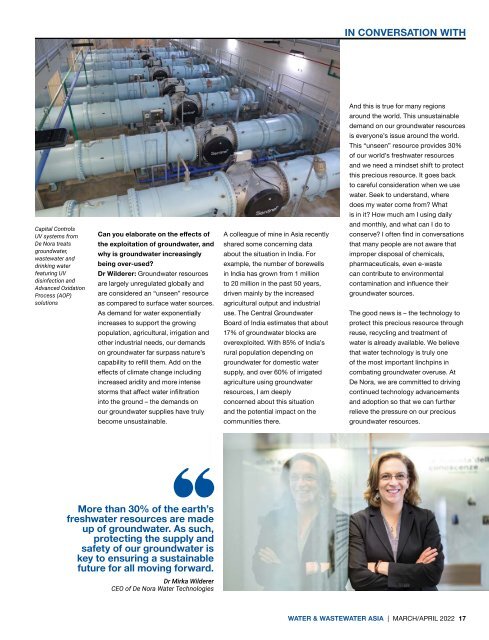Water & Wastewater Asia March/April 2022
Water & Wastewater Asia is an expert source of industry information, cementing its position as an indispensable tool for trade professionals in the water and wastewater industry. As the most reliable publication in the region, industry experts turn this premium journal for credible journalism and exclusive insight provided by fellow industry professionals. Water & Wastewater Asia incorporates the official newsletter of the Singapore Water Association (SWA).
Water & Wastewater Asia is an expert source of industry information, cementing its position as an indispensable tool for trade professionals in the water and wastewater industry. As the most reliable publication in the region, industry experts turn this premium journal for credible journalism and exclusive insight provided by fellow industry professionals. Water & Wastewater Asia incorporates the official newsletter of the Singapore Water Association (SWA).
You also want an ePaper? Increase the reach of your titles
YUMPU automatically turns print PDFs into web optimized ePapers that Google loves.
IN CONVERSATION WITH<br />
And this is true for many regions<br />
around the world. This unsustainable<br />
demand on our groundwater resources<br />
is everyone’s issue around the world.<br />
This “unseen” resource provides 30%<br />
of our world’s freshwater resources<br />
and we need a mindset shift to protect<br />
this precious resource. It goes back<br />
to careful consideration when we use<br />
water. Seek to understand, where<br />
does my water come from? What<br />
is in it? How much am I using daily<br />
Capital Controls<br />
UV systems from<br />
De Nora treats<br />
groundwater,<br />
wastewater and<br />
drinking water<br />
featuring UV<br />
disinfection and<br />
Advanced Oxidation<br />
Process (AOP)<br />
solutions<br />
Can you elaborate on the effects of<br />
the exploitation of groundwater, and<br />
why is groundwater increasingly<br />
being over-used?<br />
Dr Wilderer: Groundwater resources<br />
are largely unregulated globally and<br />
are considered an “unseen” resource<br />
as compared to surface water sources.<br />
As demand for water exponentially<br />
increases to support the growing<br />
population, agricultural, irrigation and<br />
other industrial needs, our demands<br />
on groundwater far surpass nature’s<br />
capability to refill them. Add on the<br />
effects of climate change including<br />
increased aridity and more intense<br />
storms that affect water infiltration<br />
into the ground – the demands on<br />
our groundwater supplies have truly<br />
become unsustainable.<br />
A colleague of mine in <strong>Asia</strong> recently<br />
shared some concerning data<br />
about the situation in India. For<br />
example, the number of borewells<br />
in India has grown from 1 million<br />
to 20 million in the past 50 years,<br />
driven mainly by the increased<br />
agricultural output and industrial<br />
use. The Central Groundwater<br />
Board of India estimates that about<br />
17% of groundwater blocks are<br />
overexploited. With 85% of India’s<br />
rural population depending on<br />
groundwater for domestic water<br />
supply, and over 60% of irrigated<br />
agriculture using groundwater<br />
resources, I am deeply<br />
concerned about this situation<br />
and the potential impact on the<br />
communities there.<br />
and monthly, and what can I do to<br />
conserve? I often find in conversations<br />
that many people are not aware that<br />
improper disposal of chemicals,<br />
pharmaceuticals, even e-waste<br />
can contribute to environmental<br />
contamination and influence their<br />
groundwater sources.<br />
The good news is – the technology to<br />
protect this precious resource through<br />
reuse, recycling and treatment of<br />
water is already available. We believe<br />
that water technology is truly one<br />
of the most important linchpins in<br />
combating groundwater overuse. At<br />
De Nora, we are committed to driving<br />
continued technology advancements<br />
and adoption so that we can further<br />
relieve the pressure on our precious<br />
groundwater resources.<br />
More than 30% of the earth’s<br />
freshwater resources are made<br />
up of groundwater. As such,<br />
protecting the supply and<br />
safety of our groundwater is<br />
key to ensuring a sustainable<br />
future for all moving forward.<br />
Dr Mirka Wilderer<br />
CEO of De Nora <strong>Water</strong> Technologies<br />
WATER & WASTEWATER ASIA | MARCH/APRIL <strong>2022</strong> 17


















